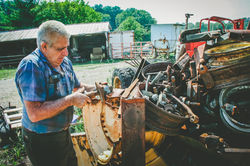
01
THE FILM
A story about redemption, Tang, and a time machine built out of used auto parts.
Wid Winner & the Slipstream is a poetic, blue-collar, coming of age story about auto parts shop worker Wid Winner. James Sheldon stars as the disenchanted counter clerk who never lived up to his own expectations.
Shell-shocked by the death of his favorite uncle, Wid (Sheldon) decides to take his first steps in a new direction. That new direction is riding shotgun with the man who has just robbed his auto parts store with a homemade taser. Alexander Wright stars as Kenneth Brown, a wandering inventor hell-bent on completing his prize possession, the Slipstream.
With little left to lose, the two lonesome men embark on a cross-country roadtrip in search of forgiveness, redemption, and enough used auto parts to build a time machine.

02
THE FACTS
A comedy. A drama.
A short. A feature.
Wid Winner & the Slipstream played at over 35 Film Festivals throughout the U.S. and won 5 "Best of" Awards.
RUNTIME: 50 MINUTES
CAPTURE FORMAT: SUPER16MM
FINAL AUDIO MIX: 5.1 Surround Sound
CAMERA: AATON XTR PROD
(with an ARRI SR3 for 2nd Unit)
FILMING LOCATIONS:
SUNLAND, CALIFORNIA SALTON SEA/BOMBAY BEACH, CALIFORNIA
2 GUNS, ARIZONA WINSLOW, ARIZONA HOLBROOK, ARIZONA
GALLUP, NEW MEXICO ALBUQUERQUE, NEW MEXICO
AMARILLO, TEXAS SHAMROCK, TEXAS
OKLAHOMA CITY, OKLAHOMA
JOPLIN, MISSOURI SPRINGFIELD, MISSOURI ST. LOUIS MISSOURI
TELL CITY, INDIANA
HAWESVILLE, KENTUCKY PARIS, KENTUCKY
 |  |
|---|---|
 |  |
 |  |
 |  |
 |  |
 |
03
THE SLIPSTREAM STORY
In Loving Wondrous Mechanical Memory of
Billy Stephens
1935-2016
written by alex o. gaynor
"I talked to production designers in Los Angeles about building “The Slipstream,” a homemade time machine constructed out of used auto parts. I had this crazed idea that it would resemble a double-helix, because time-travel and mapping of DNA must be rooted together somehow right? Go with it. But also the word Slipstream has two “SSs” that, when inverted, also made the double helix spiral. The designers were intrigued; I even visited the Deadwood set a few times to meet with some professional builders and go over drawings and ideas. But the cost of storing the Slipstream in LA was wildly expensive, let alone building it. Back to square one.
So I went home to Kentucky to fish and brainstorm; I talked with my folks.
I went boonie-cruising one afternoon and saw a 70 year old man driving a homemade forklift. Nearby was a horse carriage built out of a Ford Aerostar. Here was the guy I was looking for - farmer/inventor, genius/hero. Billy Stephens of Pellville, Kentucky, the man that just might be able to build (and store) a 12 foot tall time machine complete with dual helical spirals.
The next day, my dad and I went to his house. He was bit hard of hearing, I think “nearly-deaf” is the word, but his wife Mary Elizabeth speaks clearly enough so he could lip read, though she had to mouth the words
“Time Machine” about seven different ways because he wasn’t quite sure if I had lost my wits in my move to California (it’s possible). You see, the stuff he built had purpose, it helped him to do his chores better, he built things he needed but were too expensive to buy, like fabricating a new gas tank for his tractor out of an old Heineken keg. Me, I wanted to build a gigantic movie prop for an uncomfortably long short film that would have no actual functionality or purpose, except, of course, to create a sense of wonder.
With Mary Elizabeth as our interpreter, I laid out my elaborate isometric design for the Slipstream, a huge metal rotating sculpture, you know, like art.
He wasn’t convinced. I watched him walk around the backyard and take note of the piles of scrap metal he had hoarded over the last half century. I could almost hear him mentally unbending iron to see if it would work, then rebending it back into its place to be used for some other, more functional project. He said, “I’ll take a look at it, leave that… that drawing ‘a yers.”
I realized I’d probably never see him again, or the piece of paper with my attempted drawing.
Back in Los Angeles, I started my search for new Art Directors and Production Designers that might be willing to take on my project for low money and less time. I tried to refine the design, make it smaller, but I was losing hope.
Two weeks later I got a call from my uncle. His first words: “Man, that Slipstream thing sure is cool, Billy’s grandkids love it.” A few moments later, I got an email with a picture of Billy Stephens sitting in a 12ft tall, 400 lb., double helix-inspired contraption cut out of rusted metal he had scavenged from his own property. It was the mighty exo-skeleton of the machine that would appear in the film, and it was a total surprise. I had no idea that he had started on it or was even interested in the project.
Besides our cast, it was my first huge victory. It made me realize that the film was now actually possible, that we could make this movie outside of LA, outside “the system,” that we could break the rules, and that amazing people would come onboard and do heroic work.
That set the tone for the rest of our journey. And everytime I saw it, it did indeed create a sense of wonder.
Thank you Billy and Mary E."